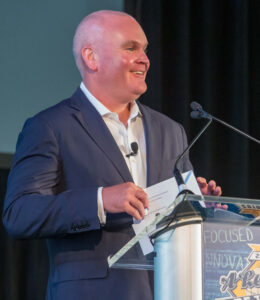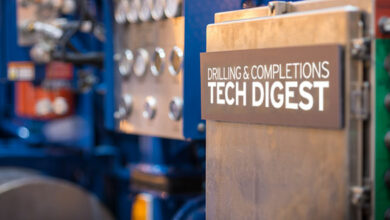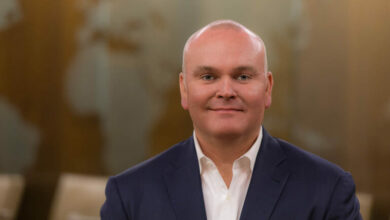2022 IADC Chairman: Industry must advocate for itself with a louder voice


Transocean’s Jeremy Thigpen urges industry to redouble efforts around education, communication to fix skewed public perceptions
By Linda Hsieh, Editor & Publisher
How does a person become the CEO of the world’s leading offshore driller at only 40 years old? Good fortune certainly plays a role, such as being in the right place at the right time. But luck isn’t everything: When opportunity comes knocking, you also have to be bold enough, decisive enough and ambitious enough to seize it. At key points throughout Jeremy Thigpen’s career, that’s exactly what he’s done.
In the 1990s, after years of playing football in high school and college, Mr Thigpen tried out for the NFL. When that didn’t pan out, he knew he had to move on. Fortunately, he was armed with a degree in economics and another in managerial studies from Rice University, and quickly secured a highly attractive and lucrative offer from Enron in natural gas trading. This was 1997 – four years before the company became mired in scandal and subsequently went bankrupt.
But as Mr. Thigpen was considering the role with Enron, another opportunity emerged when he met Pete Miller at National Oilwell, the company where Mr Thigpen had spent his high school and college summers doing manual labor in one of the company’s Houston service shops.
Mr Miller – who went on to become Chairman and CEO of National Oilwell Varco (NOV) – encouraged Mr Thigpen to instead continue working at the oilfield service company. Even though it would be a lower-paying job with a much smaller company, Mr Thigpen recalled that Mr Miller told him he would teach Mr Thigpen “everything there is to know about running a business.” The career potential somehow seemed bigger, so Mr Thigpen committed to NOV.
“Pete was true to his word, and he gave me opportunity after opportunity,” Mr Thigpen said. Not long after joining the company, Mr Thigpen spearheaded a bid to manage the global supply chain for Germany’s Deutag Drilling, with operations across the Middle East, Africa and Asia. Just a year out of college, he found himself moving to Germany and leading the implementation of new ERP systems to take over all of the drilling contractor’s warehouses and inventory.
By 2003, at only 28 years old, Mr Thigpen had been named President of NOV’s Downhole Tools Group. Under a corporate vision to create a one-stop shop for all rig equipment and streamline the newbuild construction process, he grew the Downhole Tools Group from a $175 million business with operations in the US and Canada to a $2 billion-plus business with a global footprint. Then, in 2007, Mr Thigpen took over as President of NOV’s Downhole and Pumping Solutions Group and executed a similar growth strategy. In 2012, Mr Thigpen was named SVP and CFO of NOV.
When asked why he was able to achieve so much at such a young age, Mr Thigpen said he believes he entered the industry at a time when it needed new talent. “If you think back to 1997, the industry had been in pretty bad shape for 15-20 years, so it had been difficult to attract talent. We had missed a generation. In every business, I was always 20 years younger than the people who worked for me,” he said.
This shaped his leadership style early on. “You had to probe and ask a lot of questions, and you had to trust the team around you to do their jobs. Then, as you began to learn more about the business and as you started to think about how to grow and evolve the organization, you were able to do it from a place of respect, because you’ve already built trust with the team. I think that’s been the greatest lesson I’ve learned.”

Leading a transformation at Transocean
In 2015, opportunity knocked again when Mr Thigpen learned that Transocean was seeking a new President and CEO. His mentor from NOV – Mr Miller – had taken over as Chairman of the offshore drilling company and suggested Mr Thigpen consider the position.
“My initial response was, thank you, but no,” Mr Thigpen recalled. Not only was he happy where he was, but Mr Thigpen had spent nearly 20 years helping to build NOV and thought he could someday advance into the CEO position. There was no reason for him to leave.
And yet, something told him that he shouldn’t stick with what is “safe,” that he needed to take another chance with his career. Mr Miller reminded Mr Thigpen of Transocean’s leadership position in the offshore drilling industry and that opportunities like this don’t come along often.
Looking into Transocean’s finances and operations in more detail, Mr Thigpen realized there was potential to transform the company into something even better.
“What I saw at the time was an organization with a lot of noise around it, but they had some great new assets, they operated globally, and they had a great reputation in terms of performance delivery, personnel and technical competence.” Moreover, he saw that the company was underperforming compared with competitors when it came to EBITDA margins. “That suggested something may be wrong from a cost structure perspective, and that’s something I could fix.”
In April 2015, upon joining Transocean as President and CEO, Mr Thigpen set out to learn about the offshore drilling business – something he acknowledges he didn’t know much about. But, just like his early days at NOV, he learned by asking questions and by relying on the people around him.
One of his earliest realizations about the offshore drilling business was how much higher the stakes were, versus his previous career at NOV. Whereas an oilfield equipment manufacturer like NOV had to deal with hundreds of different product lines and services, the business model for a drilling contractor was relatively simple. The challenge was all in the execution of the operation, where one mistake could potentially result in a fatality, multiple fatalities or even an environmental concern. “We have to be on our game at all times, both from a personnel standpoint and from a machine operation standpoint.”
Recognizing this fundamental principle, Mr Thigpen began to transform the company by taking a data-driven approach. First up was transforming Transocean’s assets.
The company had approximately 70 rigs in its fleet at the time – a mixed fleet that included jackups, mid-water floaters, deepwater floaters, ultra-deepwater floaters and harsh-environment semisubmersibles. “We decided that we added the most value in the most complicated areas, in those challenging environments where our customers needed and respected Transocean for delivering safe, reliable and efficient operations,” Mr Thigpen said.
The company then forced-ranked all of its rigs against the global fleet, based on criteria that it believed was important to operators. “We took an honest analysis of our fleet, and what we found was that we had some of the best rigs in the world, but we also had rigs that we recognized would probably never again get a contract. So, we started retiring rigs at a more aggressive pace than anybody else in the industry. I think we’ve retired 50-plus floaters in the past few years.”
The company also divested its jackup fleet. Transocean currently has 37 ultra-deepwater and harsh-environment floaters in its fleet and two newbuild ultra-deepwater drillships that are set to be delivered in 2022 and 2023. “Our average fleet age went from 21 years down to under 10 years,” Mr Thigpen said.
After culling its assets, Transocean then set out to improve its equipment reliability, paying especially close attention to subsea equipment as it was identified as the biggest cause of downtime.
“We took a very methodical process and broke the downtime down piece by piece,” Mr Thigpen said. Efforts here included creating what Transocean called “healthcare agreements,” which provided major suppliers with incentives for helping Transocean to improve its equipment uptime.
The company also stepped up its use of equipment sensors to collect more data for deep analytics. This then helped the team not only to identify performance anomalies but also to pinpoint possible failures, thereby eliminating a significant portion of downtime events. Other initiatives, such as digitizing operating procedures, remote monitoring and digital twins, have also contributed to efficiency gains.
Overall, Transocean has improved its uptime from an average of 92% in 2013/2014 to approximately 97% now, Mr Thigpen said. “It’s a huge difference in reliability.”
Industry and market outlook
Looking at his term as 2022 IADC Chairman, Mr Thigpen said advocacy is high on his list of priorities. “Our industry provides a higher standard of living for billions of people around the world, in so many different ways, but the public doesn’t always understand or appreciate that.”
This skewed perception of reality not only increases political pressure on the oil and gas industry – leading to unnecessary regulations and administrative burdens – but it also makes it increasingly difficult to attract capital. “This capital is required to introduce new technologies that can further reduce our impact on the environment,” Mr Thigpen said.
To overcome this, the industry will have to come together to improve education and communication. “IADC has been doing that, but I think we need to redouble our efforts around that front… The loudest voice in the room gets heard amongst the public, and right now I think we’re still a very quiet voice. First, we need to communicate the value that we create as an industry. Second, we need to talk about all the things that we are doing to improve the way we deliver our assets and services.”
For example, when it comes to sustainability, the most straightforward way for drilling contractors to reduce their emissions is to safely deliver wells faster. “Uptime performance is a huge contributor,” Mr Thigpen said, noting that better uptime means higher productivity while a rig is on location.
In October, Transocean announced a commitment to reduce its Scope 1 and Scope 2 greenhouse gas emissions intensity by 40% by 2030, compared with 2019 levels. To achieve this, Transocean will reduce emissions intensity across its fleet through fuel reductions and other initiatives that can be achieved by developing and implementing new processes and technologies to optimize power management capabilities.
Advocacy and changing the public narrative around oil and gas will also be key, Mr Thigpen believes, to addressing the industry’s next big challenge: attracting and training new talent.
It can be difficult to recruit young people who have grown up “with a negative narrative about oil and gas,” Mr Thigpen said.
In reality, future career prospects are especially bright for next-generation drilling professionals. “Like when I first started my career at NOV, there is a generational gap in many companies in this industry. The opportunities to demonstrate your abilities and progress your career are going to be great for a smart, ambitious person who believes in the value that this industry creates in the world.”
Mr Thigpen also encouraged young industry professionals to forge ahead with confidence. “We are going to be around and vital to the world for years to come,” he said. And as the drilling industry continues to transform itself with technology, there will be ample opportunity for the next generation “to bring a different slant to the application of technology, not only for the way we conduct our operations, but also for how we support our operations from the shore. It’s an exciting time.” DC




